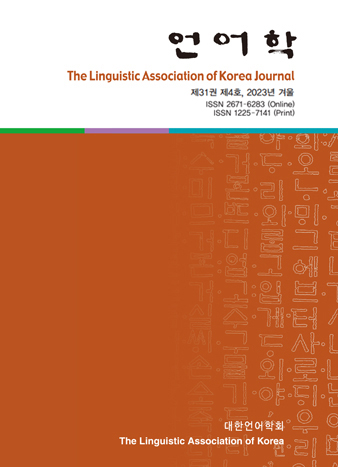대한언어학회 전자저널

31권 4호 (2023년 12월)
- Handshape Complexity in Initialized Signs: A Cross-linguistic Study
-
Hyun Jin Hwangbo · Youngju Choi
Pages : 241-264
Abstract
Hwangbo, Hyun Jin & Choi, Youngju. (2023). Handshape complexity in initialized signs: a cross-linguistic study. The Linguistic Association of Korea Journal, 31(4), 241-264. This paper presents a comprehensive phonological analysis of handshapes undergoing initialization in Korean Sign Language (KSL) and extends its findings to comparisons with other sign languages. The study investigates the complexity of these handshapes in terms of finger and joint configurations, aiming to discern universal tendencies in signs undergoing the initialization process. Results indicate that initialized handshapes in KSL and other sign languages typically exhibit low to medium complexity, suggesting the potential representation of unmarked handshapes within the language. This research lays the groundwork for future investigations, offering valuable insights into the phonological intricacies of initialized handshapes in KSL and contributing to broader cross-linguistic comparisons.
Keywords
# Korean Sign Language (KSL) # initialization # handshape # complexity # phonology # sign language
References
- Battison, R. (1978). Lexical borrowing in American Sign Language. Silver Spring, MD: Linstok Press.
- Bellugi, U. and Newkirk, D. (1981). Formal devices for creating new signs in American Sign Language. Sign Language Studies, 30, 1-35.
- Boyes Braem, P. (1990). Acquisition of the handshape in American Sign Language: A preliminary analysis. In Volterra, V. & Erting, C. J., (Eds.), From Gesture to Language in Hearing and Deaf Children (pp. 107-127). Berlin: Springer.
- Brentari, D. (1998). A prosodic model of sign language phonology. Cambridge, MA: Bradford Book.
- Brentari, D. (2011). Handshape in sign language phonology. In van Oostendorp, M., Ewen, C. J., Hume, E., & Rice, K., (Eds.), The Blackwell companion to phonology (pp. 195-222). Hoboken, NJ: Blackwell Publishing Ltd.
- Brentari, D. (2019). Sign language phonology. Cambridge, United Kingdom: Cambridge University Press.
- Brentari, D., Coppola, M., Cho, P. W., & Senghas, A. (2017). Handshape complexity as a precursor to phonology: Variation, emergence, and acquisition. Language Acquisition, 24(4), 283-306.
- Brentari, D., & Padden, C. (2001). Native and foreign vocabulary in American Sign Language: A language with multiple origins. In D. Brentari, (Ed.), Foreign vocabulary in sign language: A cross-linguistic investigation of word formation (pp. 87-119). Mahwah, NJ: Lawrence Erlbaum Associates.
- Eccarius, P., & Brentari, D. (2008). Handshape coding made easier: A theoretically based notation for phonological transcription. Sign Language & Linguistics, 11(1), 69-101.
- Lee, Y.H. (2008). A morphological study on the simultaneous complex structure of Korean Sign Language [in Korean]. Unpublished doctoral dissertation, Kangwon National University.
- Liddell, S. K. (1996). Numerical incorporating roots & non-incorporating prefixes in American Sign Language. Sign Language Studies, 92, 201-226.
- Machabée, D. (1995). Description and status of initialized signs in Quebec Sign Language. In Lucas, C., (Ed.), Sociolinguistics in deaf communities (pp. 29-61). Washington D.C: Gallaudet University Press.
- Makaroğlu, B. (2021). Blend formation in Turkish Sign Language: Are we missing the big picture? Journal of Language and Linguistic Studies, 17(1), 139-157.
- Meir, I. (2012). Word classes and word formation. In Pfau, R., Steinbach, M., & Woll, B., (Eds.), Sign language: An international handbook (pp. 77-111). Berlin/Boston: De Gruyter Mouton.
- Meir, I., & Sandler, W. (2008). A language in space: The story of Israeli Sign Language. New York: Lawrence Erlbaum Associates, Inc.
- Morgan, G., Barrett-Jones, S., & Stoneham, H. (2007). The first signs of language: Phonological development in British Sign Language. Applied Psycholinguistics, 28(1), 3-22.
- National Institute of Korean Language (2023). Korean Sign Language Dictionary. Retrieved October 15, 2023, from https://sldict.korean.go.kr/front/main/main.do
- O’Baoill, D. P., & Matthews, P. A. (2000). The Irish deaf community. Vol. 2: The structure of Irish Sign Language. Dublin: Linguistics Institute of Ireland.
- Sandler, W., & Lillo-Martin, D. C. (2006). Sign language and linguistic universals. Cambridge, UK: Cambridge University Press.
- Stokoe, W. C. (2005). Sign language structure: An outline of the visual communication system of the American Deaf. Journal of Deaf Studies and Deaf Education, 10(1), 3-37. (Reprinted from “Sign language structure: An outline of the visual communication system of the American Deaf”, 1960, Studies in Linguistics, Occasional Papers, 8, Buffalo, NY: University of Buffalo)
- Weon, S., Kim, Y., Nam, K., & Kim, S. (2021). Korean Sign Language grammar (Hankukswuemwunpeop) [in Korean]. National Institute of the Korean Language, Seoul.